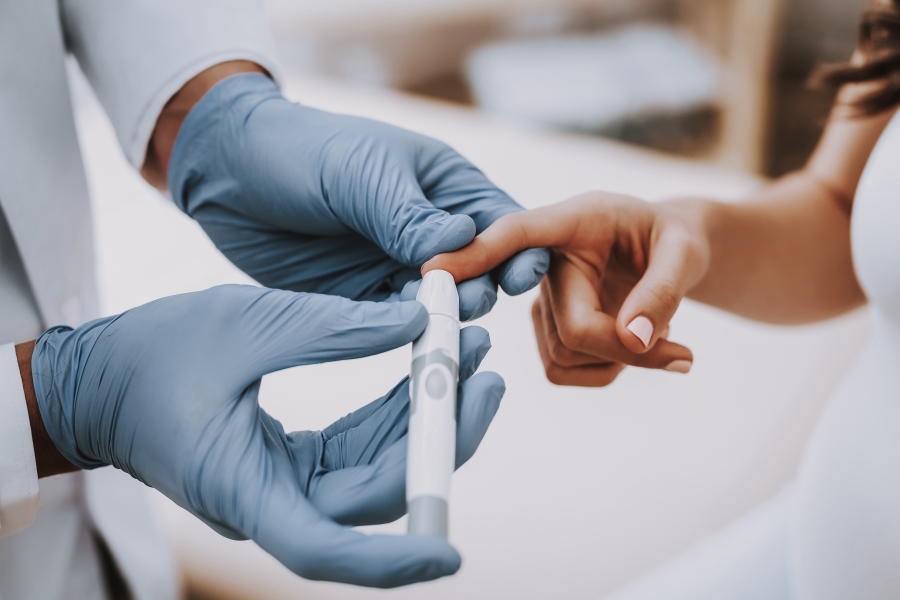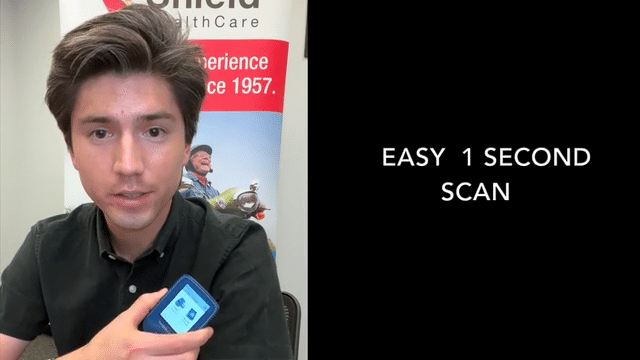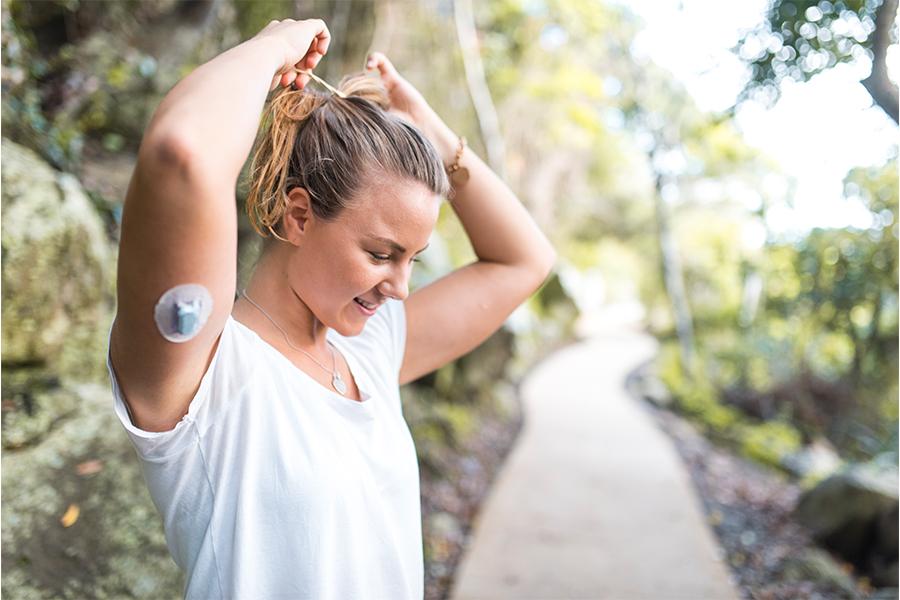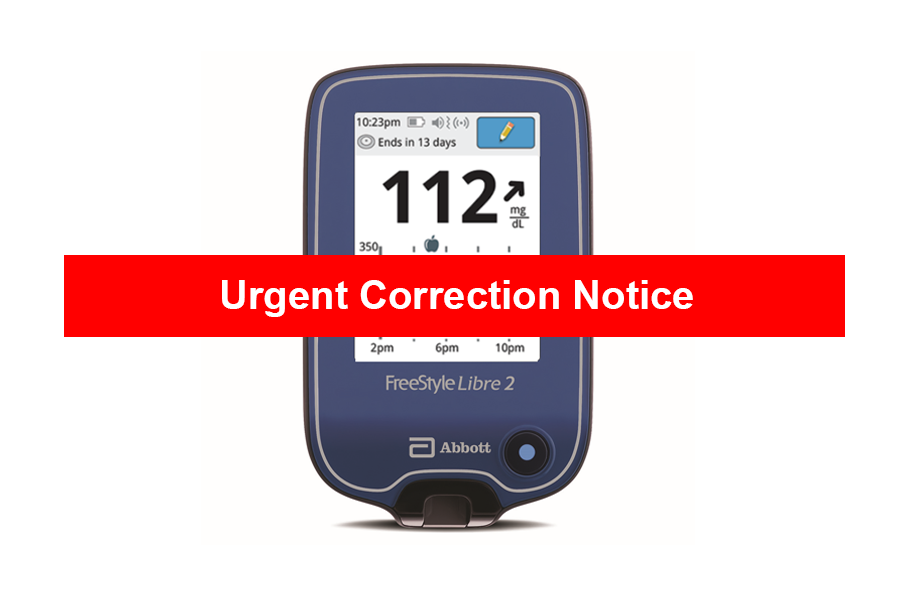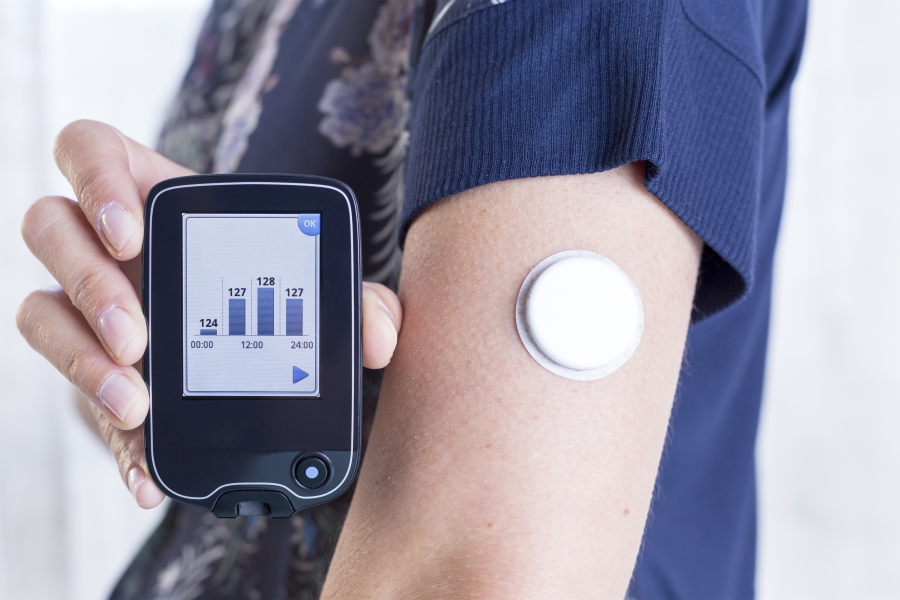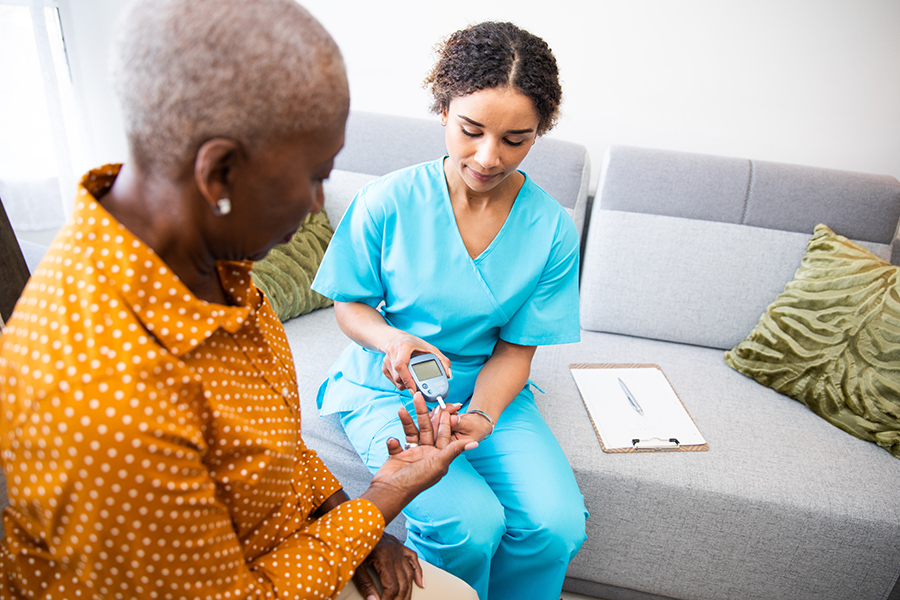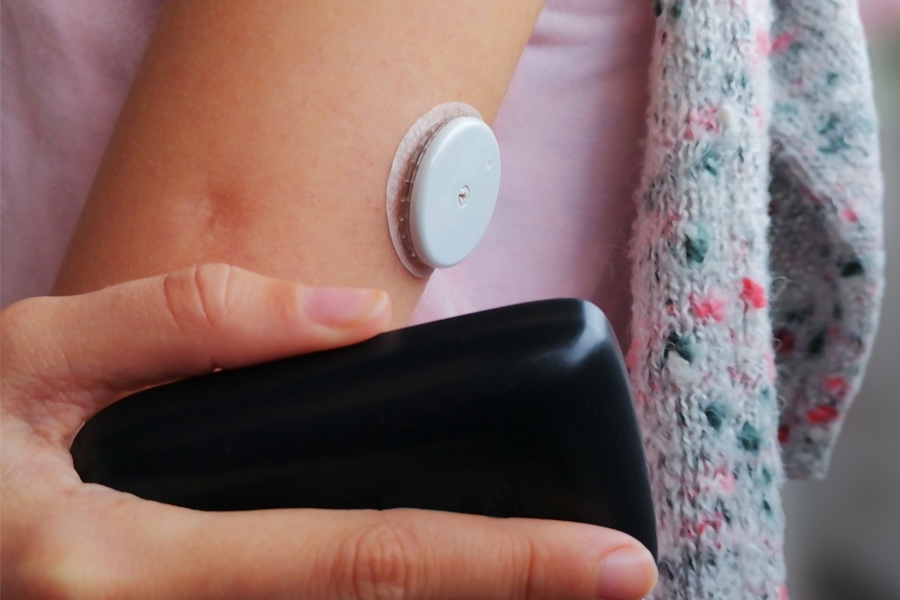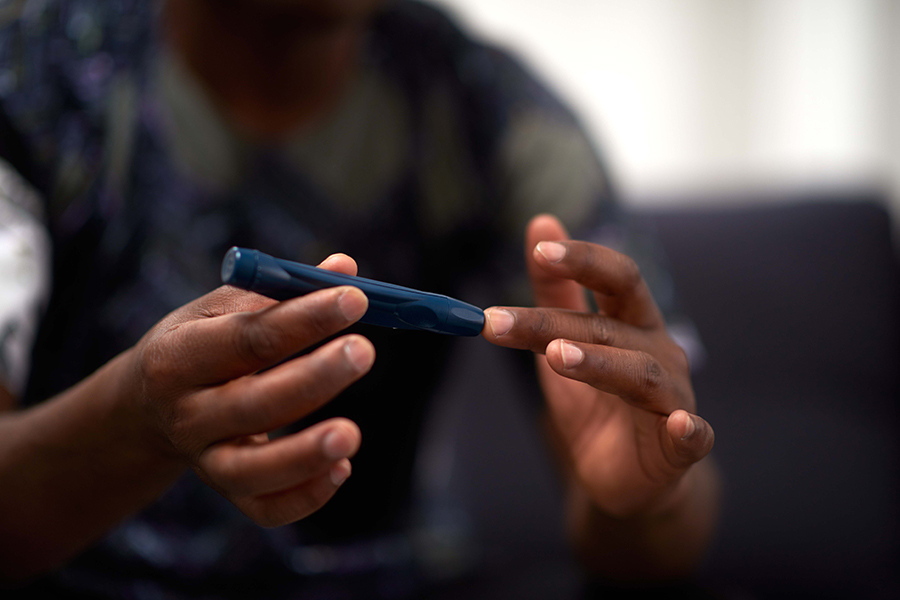Updated February 7, 2020
Learning about diabetes can be a daunting task. Use this glossary of commonly used terms to become more comfortable with diabetes jargon.
A
A1C: A test that measures a person’s average blood glucose level over the past 2 to 3 months. Also called hemoglobin A1C or glycosylated hemoglobin, the test shows the amount of glucose that sticks to the red blood cell, which is proportional to the amount of glucose in the blood.
Acute: Describes something that happens suddenly and for a short time. Opposite of chronic.
Alpha cell: A type of cell in the pancreas. Alpha cells make and release a hormone called glucagon. The body sends a signal to the alpha cells to make glucagon when blood glucose falls too low. Then glucagon reaches the liver where it tells it to release glucose into the blood for energy.
Antibodies: Proteins made by the body to protect itself from “foreign” substances such as bacteria or viruses. People get Type 1 diabetes when their bodies make antibodies that destroy the body’s own insulin-making beta cells.
Arteriosclerosis: The hardening of the arteries.
Artery: A large blood vessel that carries blood with oxygen from the heart to all parts of the body.
Atherosclerosis: Clogging, narrowing and hardening of the body’s large arteries and medium-sized blood vessels. Atherosclerosis can lead to stroke, heart attack, eye problems and kidney problems.
Autoimmune disease: Disorder of the body’s immune system in which the immune system mistakenly attacks and destroys body tissue that it believes to be foreign.
Autonomic neuropathy: Autonomic neuropathy is a group of symptoms that occur when there is damage to the nerves that manage every day body functions. These functions include blood pressure, heart rate, sweating, bowel and bladder emptying, and digestion.
B
Background retinopathy: A type of damage to the retina of the eye marked by bleeding, fluid accumulation and abnormal dilation of the blood vessels. Background retinopathy is an early stage of diabetic retinopathy. Also called simple or nonproliferative retinopathy.
Beta cell: A cell that makes insulin. Beta cells are located in the islets of the pancreas.
Blood glucose: The main sugar found in the blood and the body’s main source of energy. Also called blood sugar.
Blood glucose level: The amount of glucose in a given amount of blood. Measured in milligrams in a deciliter, or mg/dL.
Blood glucose meter: A small, portable machine used to check their blood glucose levels. After pricking the skin with a lancet, one places a drop of blood on a test strip in the machine. The meter (or monitor) soon displays the blood glucose level as a number on the meter’s digital display.
Blood pressure: The force of blood exerted on the inside walls of blood vessels. Blood pressure is expressed as a ratio (example: 120/80, read as “120 over 80”). The first number is the systolic pressure, or the pressure when the heart pushes blood out into the arteries. The second number is the diastolic pressure, or the pressure when the heart rests.
Blood vessels: Tubes that carry blood to and from all parts of the body. The three main types of blood vessels are arteries, veins and capillaries.
Body mass index (BMI): A measure used to evaluate body weight relative to a person’s height. BMI is used to find out if a person is underweight, normal weight, overweight or obese.
Borderline diabetes:A condition in which blood sugar is high, but not high enough to be type 2 diabetes.
Brittle diabetes: A term used when a person’s blood glucose level moves often from low to high and from high to low.
C
C-peptide: C-peptide is a substance that is created when the hormone insulin is produced and released into the body. The insulin C-peptide test measures the amount of this product in the blood.
Calorie: A unit representing the energy provided by food. Carbohydrate, protein, fat and alcohol provide calories in the diet. Carbohydrate and protein have 4 calories per gram, fat has 9 calories per gram, and alcohol has 7 calories per gram.
Capillary: The smallest of the body’s blood vessels. Oxygen and glucose pass through capillary walls and enter the cells. Waste products such as carbon dioxide pass back from the cells into the blood through capillaries.
Carbohydrate: One of the three main nutrients found in food. Foods that provide carbohydrate are starches, vegetables, fruits, dairy products and sugars.
Carbohydrate counting: A method of meal planning for people with diabetes based on counting the number of grams of carbohydrate in food.
Cardiologist: A doctor who treats people who have heart problems.
Cardiovascular disease: Disease of the heart and blood vessels (arteries, veins and capillaries).
Cataract: Clouding of the lens of the eye.
Cerebrovascular disease: Damage to blood vessels in the brain. Vessels can burst and bleed or become clogged with fatty deposits. When blood flow is interrupted, brain cells die or are damaged, resulting in a stroke.
Certified diabetes educator (CDE): A health care professional with expertise in diabetes education who has met eligibility requirements and successfully completed a certification exam.
Cholesterol: A type of fat produced by the liver and found in the blood; it is also found in some foods. Cholesterol is used by the body to make hormones and build cell walls.
Chronic: Describes something that is long-lasting. Opposite of acute.
Circulation: The flow of blood through the body’s blood vessels and heart.
Coma: A sleep-like state in which a person is not conscious. May be caused by hyperglycemia (high blood glucose) or hypoglycemia (low blood glucose) in people with diabetes.
Combination therapy: The use of different medicines together to manage a disease.
Congenital defects: Problems or conditions that are present at birth.
Congestive heart failure: Loss of the heart’s pumping power, which causes fluids to collect in the body, especially in the feet and lungs.
Coronary heart disease: Heart disease caused by narrowing of the arteries that supply blood to the heart. If the blood supply is cut off, the result is a heart attack.
D
Dawn phenomenon: The early-morning (4 a.m. to 8 a.m.) rise in blood glucose level.
Dehydration: The loss of too much body fluid through frequent urinating, sweating, diarrhea or vomiting.
Dextrose: The name of a simple sugar that is made from corn and is chemically identical to glucose.
Diabetes Control and Complications Trial (DCCT): A study by the National Institute of Diabetes and Digestive and Kidney Diseases, conducted from 1983 to 1993 in people with Type 1 diabetes. The study showed that intensive therapy compared to conventional therapy significantly helped prevent or delay diabetes complications. Intensive therapy included multiple daily insulin injections or the use of an insulin pump with multiple blood glucose readings each day. Complications followed in the study included diabetic retinopathy, neuropathy and nephropathy.
Diabetes educator: A health care professional who teaches people who have diabetes how to manage their diabetes. Some diabetes educators are certified diabetes educators (CDEs). Diabetes educators are found in hospitals, physician offices, managed care organizations, home health care and other settings.
Diabetes mellitus: A condition characterized by hyperglycemia resulting from the body’s inability to use blood glucose for energy. In Type 1 diabetes, the pancreas no longer makes insulin and therefore blood glucose cannot enter the cells to be used for energy. In Type 2 diabetes, either the pancreas does not make enough insulin or the body is unable to use insulin correctly.
Diabetes Prevention Program (DPP): A study by the National Institute of Diabetes and Digestive and Kidney Diseases conducted from 1998 to 2001 in people at high risk for Type 2 diabetes. All study participants had impaired glucose tolerance, also called pre-diabetes, and were overweight. The study showed that people who lost 5 to 7 percent of their body weight through a low-fat, low-calorie diet and moderate exercise (usually walking for 30 minutes 5 days a week) reduced their risk of getting Type 2 diabetes by 58 percent. Participants who received treatment with the oral diabetes drug metformin reduced their risk of getting Type 2 diabetes by 31 percent.
Diabetic diarrhea: Loose stools, fecal incontinence, or both that result from an overgrowth of bacteria in the small intestine and diabetic neuropathy in the intestines. This nerve damage can also result in constipation.
Diabetic ketoacidosis (DKA): An emergency condition in which extremely high blood glucose levels, along with a severe lack of insulin, result in the breakdown of body fat for energy and an accumulation of ketones in the blood and urine. Signs of DKA are nausea and vomiting, stomach pain, fruity breath odor and rapid breathing. Untreated DKA can lead to coma and death.
Diabetic myelopathy: Damage to the spinal cord found in some people with diabetes.
Diabetic retinopathy: Diabetic eye disease; damage to the small blood vessels in the retina. Loss of vision may result.
Diabetogenic: Causing diabetes. For example, some drugs cause blood glucose levels to rise, resulting in diabetes.
Diabetologist: A physician, usually an internist or endocrinologist, who specializes in the treatment of diabetes mellitus. See more.
Dialysis: The process of cleaning wastes from the blood artificially. This job is normally done by the kidneys. If the kidneys fail, the blood must be cleaned artificially with special equipment. The two major forms of dialysis are hemodialysis and peritoneal dialysis.
E
Endocrine gland: A group of specialized cells that release hormones into the blood. For example, the islets in the pancreas, which secrete insulin, are endocrine glands.
Endocrinologist: A doctor who treats people who have endocrine gland problems such as diabetes.
Euglycemia: A normal level of glucose in the blood.
Exchange lists: Lists provide the serving sizes for carbohydrates, meat and meat alternatives, and fats. These lists allow for substitution for different groups to keep the nutritional content fixed.
F
Fasting blood glucose test: A check of a person’s blood glucose level after the person has not eaten for 8 to 12 hours (usually overnight). This test is used to diagnose pre-diabetes and diabetes. It is also used to monitor people with diabetes.
Fat: One of the three main nutrients in food. Foods that provide fat are butter, margarine, salad dressing, oil, nuts, meat, poultry, fish and some dairy products. Excess calories are also stored as body fat, providing the body with a reserve supply of energy and other functions.
Fructosamine test: A test provides information on the average blood glucose level for the past 3 weeks.
Fructose: A sugar that occurs naturally in fruits and honey.
G
Gangrene: The death of body tissue, most often caused by a lack of blood flow and infection. It can lead to amputation.
Gastroparesis: A form of neuropathy that affects the stomach. Digestion of food may be incomplete or delayed, resulting in nausea, vomiting, or bloating, making blood glucose control difficult.
Gestational diabetes mellitus (GDM): A type of diabetes mellitus that develops only during pregnancy and usually disappears upon delivery, but increases the risk that the mother will develop diabetes later. GDM is managed with meal planning, activity, and, in some cases, insulin.
Gingivitis: A condition of the gums characterized by inflammation and bleeding.
Gland: A group of cells that secrete substances. Endocrine glands secrete hormones into the body. Exocrine glands secrete salt, enzymes and water outside of the body.
Glaucoma: An increase in fluid pressure inside the eye that may lead to loss of vision.
Glucagon: A hormone produced by the alpha cells in the pancreas. It raises blood glucose. An injectable form of glucagon, available by prescription, may be used to treat severe hypoglycemia.
Glucose: One of the simplest forms of sugar.
Glucose tablets: Chewable tablets made of pure glucose used for treating hypoglycemia.
Glycemic index: A ranking of carbohydrate-containing foods, based on the food’s effect on blood glucose compared with a standard reference food.
Glycogen: The form of glucose found in the liver and muscles.
Glycosuria: The presence of glucose in the urine.
Gram: A unit of weight in the metric system. An ounce equals 28 grams. In some meal plans for people with diabetes, the suggested amounts of food are given in grams.
H
Heredity: The passing of a trait from parent to child.
Honeymoon period: Some people with type 1 diabetes experience a brief remission. During this time their pancreas may still secrete some insulin. Over time, this secretion stops and as this happens, the child will require more insulin from injections. The honeymoon period can last weeks, months, or even up to a year or more.
Hormone: A chemical produced in one part of the body and released into the blood to trigger or regulate particular functions of the body. For example, insulin is a hormone made in the pancreas that tells other cells when to use glucose for energy. Synthetic hormones, made for use as medicines, can be the same or different from those made in the body.
Hyperglycemia: Excessive blood glucose. Fasting hyperglycemia is blood glucose above a desirable level after a person has fasted for at least 8 hours. Postprandial hyperglycemia is blood glucose above a desirable level 1 to 2 hours after a person has eaten.
Hyperinsulinemia: A condition in which the level of insulin in the blood is higher than normal. Caused by overproduction of insulin by the body. Related to insulin resistance.
Hyperosmolar hyperglycemic nonketotic syndrome (HHNS): An emergency condition in which one’s blood glucose level is very high and ketones are not present in the blood or urine. If HHNS is not treated, it can lead to coma or death.
Hypertension: A condition present when blood flows through the blood vessels with a force greater than normal. Also called high blood pressure. Hypertension can strain the heart, damage blood vessels, and increase the risk of heart attack, stroke, kidney problems and death.
Hypoglycemia: A condition that occurs when one’s blood glucose is lower than normal, usually less than 70 mg/dL. Signs include hunger, nervousness, shakiness, perspiration, dizziness or light-headedness, sleepiness, and confusion. If left untreated, hypoglycemia may lead to unconsciousness. Hypoglycemia is treated by consuming a carbohydrate-rich food such as a glucose tablet or juice. It may also be treated with an injection of glucagon if the person is unconscious or unable to swallow. Also called an insulin reaction.
Hypoglycemia unawareness: A state in which a person does not feel or recognize the symptoms of hypoglycemia. People who have frequent episodes of hypoglycemia may no longer experience the warning signs of it.
I
Immune system: The body’s system for protecting itself from viruses and bacteria or any “foreign” substances.
Impaired fasting glucose (IFG): A condition in which a blood glucose test, taken after an 8- to 12-hour fast, shows a level of glucose higher than normal but not high enough for a diagnosis of diabetes. IFG, also called pre-diabetes, is a level of 100 mg/dL to 125 mg/dL. Most people with pre-diabetes are at increased risk for developing type 2 diabetes.
Impaired glucose tolerance (IGT): A condition in which blood glucose levels are higher than normal but are not high enough for a diagnosis of diabetes. IGT, also called pre-diabetes, is a level of 140 mg/dL to 199 mg/dL 2 hours after the start of an oral glucose tolerance test. Most people with pre-diabetes are at increased risk for developing type 2 diabetes. Other names for IGT that are no longer used are “borderline,” “subclinical,” “chemical,” or “latent” diabetes.
Implantable insulin pump: A small pump placed inside the body to deliver insulin in response to remote-control commands from the user.
Impotence: The inability to get or maintain an erection for sexual activity. Also called erectile (ee-REK-tile) dysfunction (dis-FUNK-shun).
Incontinence: Loss of bladder or bowel control; the accidental loss of urine or feces.
Inhaled insulin: An experimental treatment for taking insulin using a portable device that allows a person to breathe in insulin.
Injection: Inserting liquid medication or nutrients into the body with a syringe. A person with diabetes may use short needles or pinch the skin and inject at an angle to avoid an intramuscular injection of insulin.
Injection site rotation: Changing the places on the body where insulin is injected. Rotation prevents the formation of lipodystrophies.
Injection sites: Places on the body where insulin is usually injected.
Insulin: A hormone that helps the body use glucose for energy. The beta cells of the pancreas make insulin. When the body cannot make enough insulin, it is taken by injection or through use of an insulin pump.
Insulin adjustment: A change in the amount of insulin a person with diabetes takes based on factors such as meal planning, activity and blood glucose levels.
Insulin pen: A device for injecting insulin that looks like a fountain pen and holds replaceable cartridges of insulin. Also available in disposable form.
Insulin pump: An insulin-delivering device about the size of a deck of cards that can be worn on a belt or kept in a pocket. An insulin pump connects to narrow, flexible plastic tubing that ends with a needle inserted just under the skin. Users set the pump to give a steady trickle or basal amount of insulin continuously throughout the day. Pumps release bolus doses of insulin (several units at a time) at meals and at times when blood glucose is too high, based on programming done by the user.
Insulin reaction: When the level of glucose in the blood is too low (at or below 70 mg/dL). Also known as hypoglycemia.
Insulin receptors: Areas on the outer part of a cell that allow the cell to bind with insulin in the blood. When the cell and insulin bind, the cell can take glucose from the blood and use it for energy.
Insulin resistance: The body’s inability to respond to and use the insulin it produces. Insulin resistance may be linked to obesity, hypertension, and high levels of fat in the blood.
Insulinoma: A tumor of the beta cells in the pancreas. An insulinoma may cause the body to make extra insulin, leading to hypoglycemia.
Intensive therapy: A treatment for diabetes in which blood glucose is kept as close to normal as possible through frequent injections or use of an insulin pump; meal planning; adjustment of medicines; and exercise based on blood glucose test results and frequent contact with a person’s health care team.
Intramuscular injection: Inserting liquid medication into a muscle with a syringe. Glucagon may be given by subcutaneous or intramuscular injection for hypoglycemia.
Islet cell autoantibodies (ICA): Proteins found in the blood of people newly diagnosed with Type 1 diabetes. They are also found in people who may be developing Type 1 diabetes. The presence of ICA indicates that the body’s immune system has been damaging beta cells in the pancreas.
Islet transplantation: Moving the islets from a donor pancreas into a person whose pancreas has stopped producing insulin. Beta cells in the islets make the insulin that the body needs for using blood glucose.
Islets: Groups of cells located in the pancreas that make hormones that help the body break down and use food. For example, alpha cells make glucagon and beta cells make insulin. Also called islets of Langerhans (LANG-er-hahns).
J
Jet injector: A device that uses high pressure instead of a needle to propel insulin through the skin and into the body.
K
Ketone: A chemical produced when there is a shortage of insulin in the blood and the body breaks down body fat for energy. High levels of ketones can lead to diabetic ketoacidosis and coma. Sometimes referred to as ketone bodies.
Ketonuria: A condition occurring when ketones are present in the urine, a warning sign of diabetic ketoacidosis.
Ketosis: A ketone buildup in the body that may lead to diabetic ketoacidosis. Signs of ketosis are nausea, vomiting, and stomach pain.
Kidney failure: A chronic condition in which the body retains fluid and harmful wastes build up because the kidneys no longer work properly. A person with kidney failure needs dialysis or a kidney transplant. Also called end-stage renal (REE-nul) disease or ESRD.
Kidneys: The two bean-shaped organs that filter wastes from the blood and form urine. The kidneys are located near the middle of the back. They send urine to the bladder.
L
Lancet: A spring-loaded device used to prick the skin with a small needle to obtain a drop of blood for blood glucose monitoring.
Latent autoimmune diabetes in adults (LADA): A condition in which Type 1 diabetes develops in adults.
Lipid: A term for fat in the body. Lipids can be broken down by the body and used for energy.
Lipohypertrophy: Buildup of fat below the surface of the skin, causing lumps. Lipohypertrophy may be caused by repeated injections of insulin in the same spot.
Liver: An organ in the body that changes food into energy, removes alcohol and poisons from the blood, and makes bile, a substance that breaks down fats and helps rid the body of wastes.
M
Macrosomia: Abnormally large; in diabetes, refers to abnormally large babies that may be born to women with diabetes.
Macrovascular disease: Disease of the large blood vessels, such as those found in the heart. Lipids and blood clots build up in the large blood vessels and can cause atherosclerosis, coronary heart disease, stroke, and peripheral vascular disease.
Macular edema: Swelling of the macula.
Mastopathy, diabetic: A rare fibrous breast condition occurring in women, and sometimes men, with long-standing diabetes. The lumps are not malignant and can be surgically removed, although they often recur.
Maturity-onset diabetes of the young (MODY): A kind of Type 2 diabetes that accounts for 1 to 5 percent of people with diabetes. Of the six forms identified, each is caused by a defect in a single gene.
Metabolism: The term for the way cells chemically change food so that it can be used to store or use energy and make the proteins, fats, and sugars needed by the body.
mg/dL: Milligrams per deciliter, a unit of measure that shows the concentration of a substance in a specific amount of fluid. In the United States, blood glucose test results are reported as mg/dL. Medical journals and other countries use millimoles per liter (mmol/L). To convert to mg/dL from mmol/L, multiply mmol/L by 18. Example: 10 mmol/L ? 18 = 180 mg/dL.
Microalbuminuria: The presence of small amounts of albumin, a protein, in the urine. Microalbuminuria is an early sign of kidney damage, or nephropathy, a common and serious complication of diabetes. The ADA recommends that people diagnosed with type 2 diabetes be tested for microalbuminuria at the time they are diagnosed and every year thereafter; people with type 1 diabetes should be tested 5 years after diagnosis and every year thereafter. Microalbuminuria is usally managed by improving blood glucose control, reducing blood pressure, and modifying the diet.
Microaneurysm: A small swelling that forms on the side of tiny blood vessels. These small swellings may break and allow blood to leak into nearby tissue. People with diabetes may get microaneurysms in the retina of the eye.
Microvascular disease: Disease of the smallest blood vessels, such as those found in the eyes, nerves, and kidneys. The walls of the vessels become abnormally thick but weak. Then they bleed, leak protein, and slow the flow of blood to the cells.
Mixed dose: A combination of two types of insulin in one injection. Usually a rapid- or short-acting insulin is combined with a longer acting insulin (such as NPH insulin) to provide both short-term and long-term control of blood glucose levels.
mmol/L: Millimoles per liter, a unit of measure that shows the concentration of a substance in a specific amount of fluid. In most of the world, except for the United States, blood glucose test results are reported as mmol/L. In the United States, milligrams per deciliter (mg/dL) is used. To convert to mmol/L from mg/dL, divide mg/dL by 18. Example: 180 mg/dL ? 18 = 10 mmol/L.
Mononeuropathy: Neuropathy affecting a single nerve.
Myocardial infarction: An interruption in the blood supply to the heart because of narrowed or blocked blood vessels. Also called a heart attack.
N
Nephrologist: A doctor who treats people who have kidney problems.
Nephropathy: Disease of the kidneys. Hyperglycemia and hypertension can damage the kidneys’ glomeruli. When the kidneys are damaged, protein leaks out of the kidneys into the urine. Damaged kidneys can no longer remove waste and extra fluids from the bloodstream.
Neurologist: A doctor who specializes in problems of the nervous system, such as neuropathy.
Neuropathy: Disease of the nervous system. The three major forms in people with diabetes are peripheral neuropathy, autonomic neuropathy, and mononeuropathy. The most common form is peripheral neuropathy, which affects mainly the legs and feet.
Noninvasive blood glucose monitoring: Measuring blood glucose without pricking the finger to obtain a blood sample.
O
Obstetrician: A doctor who treats pregnant women and delivers babies.
Ophthalmologist: A medical doctor who diagnoses and treats all eye diseases and eye disorders. Ophthalmologists can also prescribe glasses and contact lenses.
Optician: A health care professional who dispenses glasses and lenses. An optician also makes and fits contact lenses.
Optometrist: A primary eye care provider who prescribes glasses and contact lenses. Optometrists can diagnose and treat certain eye conditions and diseases.
Oral glucose tolerance test (OGTT): A test to diagnose pre-diabetes and diabetes. The oral glucose tolerance test is given by a health care professional after an overnight fast. A blood sample is taken, then the patient drinks a high-glucose beverage. Blood samples are taken at intervals for 2 to 3 hours. Test results are compared with a standard and show how the body uses glucose over time.
Oral hypoglycemic agents: Medicines taken by mouth by people with Type 2 diabetes to keep blood glucose levels as close to normal as possible. Classes of oral hypoglycemic agents are alpha-glucosidase inhibitors, biguanides, D-phenylalanine derivatives, meglitinides, sulfonylureas, and thiazolidinediones.
Overweight: An above-normal body weight; having a body mass index of 25 to 29.9.
P
Pancreas: An organ that makes insulin and enzymes for digestion. The pancreas is located behind the lower part of the stomach and is about the size of a hand.
Pancreas transplantation: A surgical procedure to take a healthy whole or partial pancreas from a donor and place it into a person with diabetes.
Pediatric endocrinologist: A doctor who treats children who have endocrine gland problems such as diabetes.
Pedorthist: A health care professional who specializes in fitting shoes for people with disabilities or deformities. A pedorthist can custom-make shoes or orthotics (special inserts for shoes).
Periodontal disease: Disease of the gums.
Periodontist: A dentist who specializes in treating people who have gum diseases.
Peripheral neuropathy: Nerve damage that affects the feet, legs, or hands. Peripheral neuropathy causes pain, numbness, or a tingling feeling.
Peripheral vascular disease (PVD): A disease of the large blood vessels of the arms, legs, and feet. PVD may occur when major blood vessels in these areas are blocked and do not receive enough blood. The signs of PVD are aching pains and slow-healing foot sores.
Pharmacist: A health care professional who prepares and distributes medicine to people. Pharmacists also give information on medicines.
Podiatrist: A doctor who treats people who have foot problems. Podiatrists also help people keep their feet healthy by providing regular foot examinations and treatment.
Podiatry: The care and treatment of feet.
Point system: A meal planning system that uses points to rate the caloric content of foods.
Polydipsia (pah-lee-DIP-see-uh)
Excessive thirst; may be a sign of diabetes.
Polyphagia: Excessive hunger; may be a sign of diabetes.
Polyuria: Excessive urination; may be a sign of diabetes.
Postprandial blood glucose: The blood glucose level taken 1 to 2 hours after eating.
Pre-diabetes: A condition in which blood glucose levels are higher than normal but are not high enough for a diagnosis of diabetes. People with pre-diabetes are at increased risk for developing Type 2 diabetes and for heart disease and stroke. Other names for pre-diabetes are impaired glucose tolerance and impaired fasting glucose.
Preprandial blood glucose (pree-PRAN-dee-ul)
The blood glucose level taken before eating.
Prevalence: The number of people in a given group or population who are reported to have a disease.
Proliferative retinopathy: A condition in which fragile new blood vessels grow along the retina and in the vitreous humor of the eye.
Protein: One of the three main nutrients in food. Foods that provide protein include meat, poultry, fish, cheese, milk, dairy products, eggs, and dried beans. Proteins are also used in the body for cell structure, hormones such as insulin, and other functions.
Q
R
Rebound hyperglycemia: A swing to a high level of glucose in the blood after a low level. See Somogyi effect.
Recognized Diabetes Education Programs: Diabetes self-management education programs that are approved by the American Diabetes Association.
Registered dietitian nutritionist (RDN): A health care professional who advises people about meal planning, weight control and diabetes management and who have met eligibility requirements and successfully completed a certification exam. Also known as RDs.
Renal: Having to do with the kidneys. A renal disease is a disease of the kidneys. Renal failure means the kidneys have stopped working.
Renal threshold of glucose: The blood glucose concentration at which the kidneys start to excrete glucose into the urine.
Retina: The light-sensitive layer of tissue that lines the back of the eye.
Retinopathy: Eye disease that is caused by damage to the small blood vessels in the retina. Loss of vision may result. (Also known as diabetic retinopathy)
Risk factor: Anything that raises the chances of a person developing a disease.
S
Saccharin: A sweetener with no calories and no nutritional value.
Secondary diabetes: A type of diabetes caused by another disease or certain drugs or chemicals.
Self-management: In diabetes, the ongoing process of managing diabetes. Includes meal planning, planned physical activity, blood glucose monitoring, taking diabetes medicines, handling episodes of illness and of low and high blood glucose, managing diabetes when traveling, and more. The person with diabetes designs his or her own self-management treatment plan in consultation with a variety of health care professionals such as doctors, nurses, dietitians, pharmacists, and others.
Sharps container: A container for disposal of used needles and syringes; often made of hard plastic so that needles cannot poke through.
Side effects: The unintended action(s) of a drug.
Sliding scale: A set of instructions for adjusting insulin on the basis of blood glucose test results, meals, or activity levels.
Somogyi effect, also called rebound hyperglycemia: When the blood glucose level swings high following hypoglycemia. The Somogyi effect may follow an untreated hypoglycemic episode during the night and is caused by the release of stress hormones.
Sorbitol: A sugar alcohol (sweetener) with 2.6 calories per gram. Or a substance produced by the body in people with diabetes that can cause damage to the eyes and nerves.
Starch: Another name for carbohydrate, one of the three main nutrients in food.
Stroke: Condition caused by damage to blood vessels in the brain; may cause loss of ability to speak or to move parts of the body.
Subcutaneous injection: Putting a fluid into the tissue under the skin with a needle and syringe.
Sucralose: A sweetener made from sugar but with no calories and no nutritional value.
Sucrose: A two-part sugar made of glucose and fructose. Known as table sugar or white sugar, it is found naturally in sugar cane and in beets.
Sugar: A class of carbohydrates with a sweet taste, including glucose, fructose and sucrose. And a term used to refer to blood glucose.
Sugar alcohols: Sweeteners that produce a smaller rise in blood glucose than other carbohydrates. Their calorie content is about 2 calories per gram. Includes erythritol, hydrogenated starch hydrolysates, isomalt, lactitol, maltitol, mannitol, sorbitol, and xylitol. Also known as polyols (PAH-lee-alls.)
Sugar diabetes: Former term for diabetes mellitus.
Syringe: A device used to inject medications or other liquids into body tissues. The syringe for insulin has a hollow plastic tube with a plunger inside and a needle on the end.
T
Type 1 diabetes: Formally known as insulin-dependent diabetes mellitus (IDDM) and juvenile diabetes. A condition characterized by high blood glucose levels caused by a total lack of insulin. Occurs when the body’s immune system attacks the insulin-producing beta cells in the pancreas and destroys them. The pancreas then produces little or no insulin. Type 1 diabetes develops most often in young people but can appear in adults.
Type 2 diabetes: Formally called Noninsulin-dependent diabetes mellitus (NIDDM) or adult-onset diabetes. A condition characterized by high blood glucose levels caused by either a lack of insulin or the body’s inability to use insulin efficiently. Type 2 diabetes develops most often in middle-aged and older adults but can appear in young people.
U
Ulcer: A deep open sore or break in the skin.
Unit of insulin: The basic measure of insulin. U-100 insulin means 100 units of insulin per milliliter (mL) or cubic centimeter (cc) of solution. Most insulin made today in the United States is U-100.
Urea: A waste product found in the blood that results from the normal breakdown of protein in the liver. Urea is normally removed from the blood by the kidneys and then excreted in the urine.
Urine: The liquid waste product filtered from the blood by the kidneys, stored in the bladder, and expelled from the body by the act of urinating.
Urine testing: Also called urinalysis; a test of a urine sample to diagnose diseases of the urinary system and other body systems. Urine may also be checked for signs of bleeding. Some tests use a single urine sample. For others, 24-hour collection may be needed. And sometimes a sample is “cultured” to see exactly what type of bacteria grows.
Urologist: A doctor who treats people who have urinary tract problems. A urologist also cares for men who have problems with their genital organs, such as impotence.
V
Vascular: Relating to the body’s blood vessels.
Vein: A blood vessel that carries blood to the heart.
Void: To urinate; to empty the bladder.
W
Wound care: Steps taken to ensure that a wound such as a foot ulcer heals correctly. People with diabetes need to take special precautions so wounds do not become infected.
X
Xylitol: A carbohydrate-based sweetener found in plants and used as a substitute for sugar; provides calories. Found in some mints and chewing gum.
Y
Z
50/50 insulin: Premixed insulin that is 50 percent intermediate-acting (NPH) insulin and 50 percent short-acting (regular) insulin.
70/30 insulin: Premixed insulin that is 70 percent intermediate-acting (NPH) insulin and 30 percent short-acting (regular) insulin.






